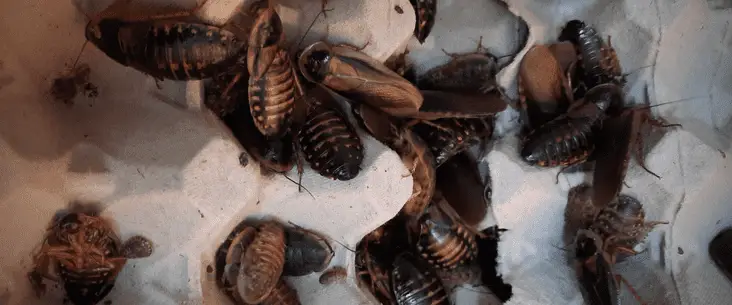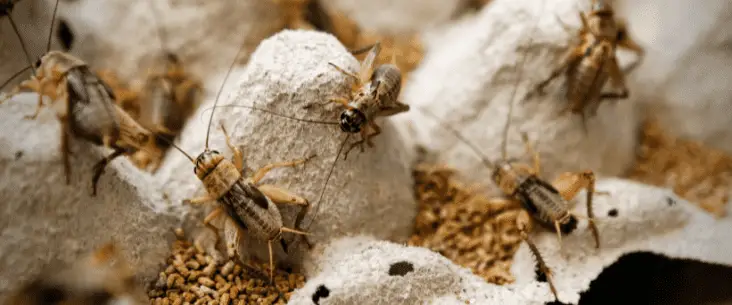If you compare the keeping and breeding of dubia roaches and crickets, you see many similarities in how we house them and which materials we use. For example, both do like egg flats, and both breed very well around the same temperature and humidity. So, I was wondering, why not placing them together in one enclosure? Is this not making the care for these feeder insects much easier? In this article, we discuss if you can keep dubia roaches and crickets together.
You can keep dubia roaches and crickets together. Both species will survive. However, placing them together will negatively affect the reproduction outcome, feeder insect quality, and ease of maintenance and management. When you keep them as feeder insects, it would be better to house them separately.
So yes, you can. But it is better that you shouldn’t place them together. Let me explain why that is.
Placing dubia roaches and crickets together: 5 reasons why you shouldn’t
If you place crickets and dubia roaches together in an enclosure with enough space and plenty of hides, they both will survive and keep reproducing. They won’t heavily compete on food or territory. But still, it will affect both populations.
Most people keep breeding populations of crickets and dubia roaches for the sole purpose to use as food for other pet animals. And placing them together will adversily effect the animals to use as feeder insect. I’ll discuss five reasons why you shouldn’t place them together.
Decrease in breeding outcome
The first reason and one of the biggest impacts is the decrease in breeding outcomes. Although they will reproduce at a normal rate, both young and adult specimens’ survival rate will decrease.
For both species applies, they will nibble on the other species when newly hatched/born or molt. In both cases, the exoskeleton is still soft, and at that point, they are most vulnerable.
Although I haven’t found any scientific proof of this, many keepers (including me) believe that placing them together will also cause them stress. We know from tarantulas, for example, that they experience a lot of stress when they are disturbed during the molting process. There are even reports that tarantulas have died because of it.
Now, imagine that this will continuously occur every time they molt. We can at least say that this will not contribute to their survival or their general health.
Decrease in overall feeder quality
Another main reason why it is not (commonly) done is the decrease in these feeder insects’ quality.
Normally, you have them housed separately. You can adjust the housing, the climate, the food, and the cleanliness and management of the species to keep them as healthy and nutritious as possible.
When placing different species together in one enclosure, one species’ adjustment and benefit may affect the other species.
For example, crickets need a high protein diet to make them nutritious. Dubia roaches, on the other hand, don’t need high protein in their diet, and this will even make dubia roaches unhealthy food for reptiles (dubia roaches fed with a high protein food will convert this protein in their body as a uric acid, which can cause gout at reptiles).
More difficult to manage
For the reasons above included, it is more difficult to manage both species in the same enclosure. We already mentioned the control of climate and cleaning of the environment.
But it makes it also more difficult to manage them. Breeding feeder insect needs certain management, like rotating egg bins or separate different life stages. Now you have to do this with both species within the same enclosure.
Cost more time
And logically, when it is more difficult to manage both species (not even mentioning to care for them without them escaping), it will also cost more time to give them the proper care they need.
So, don’t think placing them together make it twice as fast, or making feeder insects a quick job. No, it would be sooner the other way around.
Higher chance of spreading disease
One last thing you need to consider is that the species can transmit diseases to the other animals. Where one insect can maybe only carry a disease without any problems, this can be deadly to the other. And not only to a couple of feeder insects but to your whole feeder insect colony.
Keep them separate will decrease the likelihood that diseases will spread between both species.

Can you place other feeder insects together?
You may wonder if you can place other feeder insects together instead. Well, for the same reasons above, it is not recommended to do so.
For any feeder insect species, you get the highest breeding outcomes and quality by keeping them separately. Although I haven’t tested all combinations of feeder insects together, most feeder insects can’t even be housed together because of their different needs.
And why would you want to try it? It is much easier to have them separately. This way, you can make little adjustments to improve your feeder insects’ overall quality and make them as healthy and happy as possible. Placing feeder insects together does not have any perks.
Dubia roaches vs. crickets: Which one to choose?
When you only have space for one feeder insect, which one should you choose: dubia roaches or crickets? Well, this highly depends on want you want and what you need.
It mostly depends on what animals you wish to feed and how many insect-eating pets you have. For example, if you have many tarantulas, I recommend you starting a cricket breeding colony. Solely because crickets are a good staple food for tarantulas. If you have many larger lizards, it would probably be better to start a breeding colony of dubia roaches.
Personally, if I solely have to choose between the species, without the consideration why I need the feeder insects in the first place, I would choose to breed dubia roaches.
Here is the reasons why:
| Dubia roaches | Crickets | |
| Smell? | No | Yes |
| Can jump? | No | Yes |
| Escape artist? | No | Yes |
| Can bite? | No | Yes |
| Make noise? | No | Yes |
| Live long? | Yes | No |
| Meaty food? | Yes | No |
Although there are more things you need to consider, dubia roaches are very easy feeder insects to breed at home. So if you can choose and you could easily feed both, I recommend you to try breeding dubia roaches.
Further reading
If you like to know more about the care for feeder insects, I can recommend you to read our general care guide for feeder insects.
Breeding dubia roaches is easy and rather cheap. It is one of the easiest prey items you can breed at home. Read the extensive practical guide on how to breed dubia roaches.
More interested in breeding feeder crickets? Well, we also have written an extensive guide on how to breed your own feeder crickets easily. Please go check it out!
Share this page!



